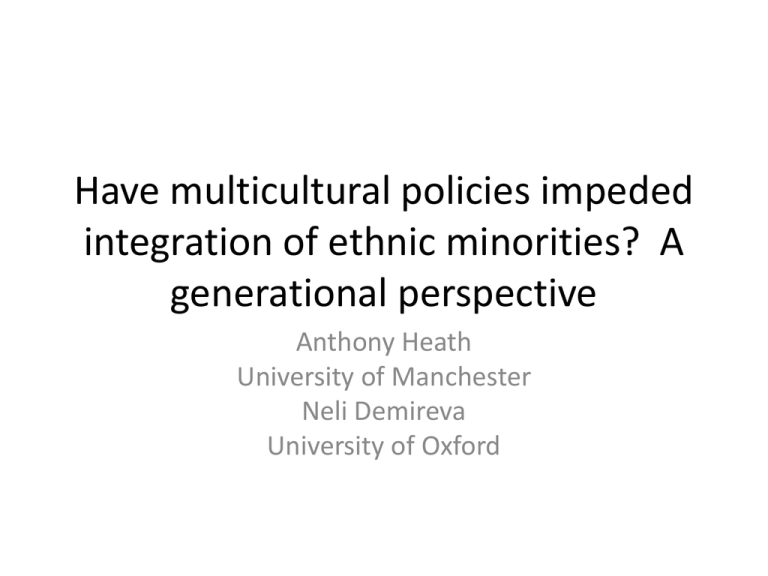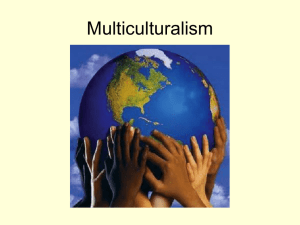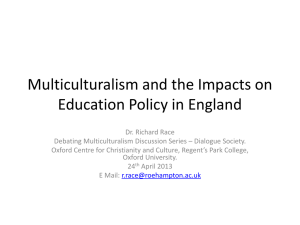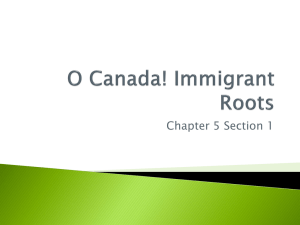Has multiculturalism utterly failed in Britain?
advertisement

Have multicultural policies impeded integration of ethnic minorities? A generational perspective Anthony Heath University of Manchester Neli Demireva University of Oxford What the politicians say • “Under the doctrine of state multiculturalism, we have encouraged different cultures to live separate lives, apart from each other and apart from the mainstream” (Cameron 2011) • Britain is “sleepwalking to segregation” (Trevor Phillips, head of the EHRC, 2005) • “The tendency had been to say ‘Let’s adopt the multikulti concept and live happily side by side, and be happy to be living with each other’, but this concept has failed, and failed utterly” (Merkel 2010) • Multiculturalism has failed in Europe, and has proven to be as harmful as the assimilationst approach it replaced (Council of Europe, 2008) What some academics say “Multicultural policies – which grant immigrants easy access to equal rights and do not provide strong incentives for host-country language acquisition and interethnic contacts – when combined with a generous welfare state … display relatively poor integration outcomes. Countries that either had more restrictive or assimilationist integration policies or a relatively lean welfare state have achieved better integration results.” (Koopmans 2010) A rival view “Multiculturalism provides a locus for the high level of mutual identification among native-born citizens and immigrants in Canada … The fact that Canada has officially defined itself as a multicultural nation means that immigrants are a constituent part of the nation that citizens feel pride in, so multiculturalism helps native-born citizens to link national identity to solidarity with immigrants and minorities. And, conversely, multiculturalism provides a link by which immigrants and minorities come to identify with, and feel pride in, Canada” (Kymlicka 2010) So what is multiculturalism? • A normative political theory maintaining the inadequacy of standard liberal principles in the face of cultural diversity. Not only individuals but also communities need to have rights (Lord Parekh, Rethinking Multiculturalism). • Organizations should therefore be encouraged “to devise policies that promote diversity as well as equality … and to stress that the country is both a community of citizens and a community of communities, both a liberal and a plural society” (Report of the Commission on the future of multiethnic Britain) MCP Index (Banting and Kymlicka) 1. Official affirmation of multiculturalism 2. Adoption of multiculturalism in school curricula 3. Inclusion of ethnic representation in licensing of public media 4. Exemptions from dress codes 5. Allowing of dual citizenship 6. Funding of ethnic organizations to support cultural activities 7. Funding of bilingual education or mother-tongue teaching 8. Affirmative action for disadvantaged groups Some queries about MCPs • Affirmative action – some forms of affirmative action (which do not involve quotas) could be justified under straightforward liberal principles to remedy discrimination (cf Brian Barry ‘the muddles of multiculturalism’) • Faith schools - some policies, eg Swedish independent schools, unintentionally permit minorities to establish their own faith schools. Is this multiculturalism or simply extending same rights to minorities as to other established groups? MC needs to be distinguished from • Assimilationist regimes (eg France) with limitations on freedom to practice own culture • Classic liberalism with freedom to practice own culture and anti-discrimination measures • Plural/pillarized regimes where there are parallel structures covering economic and political as well as cultural institutions. These are not multicultural but segmented societies (eg BiH) • i.e. a spectrum ranging from assimilationist to segmented regimes with multiculturalism lying in between MCP index 1980-2010 Canada Denmark France Netherlands Sweden Switzerland UK 1980 5 0 1 2.5 3 0 2.5 2000 7.5 0.5 2 5.5 5 1 5.5 2010 7.5 0 2 2 7 1 5.5 Britain – a ‘thin’ version of multiculturalism 1. Lukewarm official affirmation of multiculturalism – Swann report 2. Limited adoption of multiculturalism in school curricula 3. No inclusion of ethnic representation in licensing of public media 4. Exemptions from dress codes, especially for Sikhs 5. Allows dual citizenship 6. Limited funding of ethnic organizations to support cultural activities 7. Limited funding of bilingual education or mother-tongue teaching 8. Weak affirmative action for disadvantaged groups What outcomes do critics object to? • Inability to communicate in host-country language (Merkel) • Segregated communities (Phillips, Cameron) • Lack of economic and political participation (Koopmans) • Failure to adopt liberal western values and maintenance of illiberal practices, eg forced marriages (Cameron) • Crime, extremism and home-grown terrorism (Cameron) And what do supporters claim? • Multiculturalism encourages take-up of citizenship and hence political participation • Promotes educational and occupational success • promotes dual identities, eg as both Canadian and minority, and national pride • Encourages pro-minority attitudes among majority group too. (Kymlicka 2010) Our empirical approach • Key test is attitudes and behaviour of the second generation – not surprising if first generation have difficulty learning English, retain identification with origin country or remain encapsulated in the ethnic community • Key worry of critics is ‘home-grown’ terrorism among the second generation • Hence need to look at direction of generational change An important caveat • Very difficult to determine whether outcomes (good or bad) are actually caused by the MCPs. • Rigorous policy evaluation is very difficult – requires pre/post designs not cross-sectional ones • But can ask whether groups that have been granted more protection for cultural practices (eg Sikhs) have integrated less than groups not seeking or granted cultural protection (Caribbeans) cf Statham and Koopmans Outcomes we can look at • • • • • • • Citizenship Language Social segregation Political participation Democratic values Identities Support for violent protests The data • The 2010 Ethnic Minority British Election Survey (EMBES) • Thanks to the ESRC for their generous funding of the study • To the Electoral Commission for their support and partnership • To TNS-BMRB (Nick Howat, Oliver Norden, Emily Pickering) for their work on design and fieldwork • To our Advisory Board - Irene Bloemraad, John Curtice, Harry Goulbourne, Chris Myant, Maajid Nawaz, Lucinda Platt, Peter Riddell, Shamit Saggar, Will Somerville, David Voas Design 1 • Stand-alone survey rather than a booster to the main BES (ie separate sample design etc) • Nationally-representative probability sample • Clustered, stratified design with over-sampling in high EM density areas and exclusion of lowest density areas (< 2% EM) • PAF used as sample frame • LSOAs were the PSUs (unlike main BES) • Initial screening of addresses Design 2 • • • • 30,000 addresses issued for screening In 620 PSUs £20 conditional incentive offered to participants 50 minute questionnaire, administered by CAPI with a self-completion module for confidential items • Around half items exact replications of those in main BES • Short mailback questionnaire Response • 2787 respondents in total (including some from mixed and other backgrounds who had been indicated as belonging to one of the 5 target groups at screening) • Response rate of 58 – 62% (depending on method of treating those with unknown ethnicity from the screening exercise) • Poor response to mailback – 975 returned Sample characteristics White British Other white Mixed Indian Pakistani Bangladeshi Black Caribbean Black African Other EMBES 0 0 113 587 668 270 598 525 26 BES 3126 57 32 52 17 8 31 38 59 % having British citizenship 1st gen 96 100 100 99 1.5 100 100 2nd gen 100 98 96 100 100 88 87 78 73 72 62 52 49 49 0 Sikh Hindu Pakistani Bangladeshi Caribbean Nigerian Somali % speaking English well 1st gen 95 100 100 1.5 96 90 2nd gen 95 100 98 100 98 100 100 86 80 78 67 47 40 38 24 0 Sikh Hindu Pakistani Bangladeshi Caribbean Nigerian Somali % with half or more friends from a different ethnic background 1st gen 1.5 2nd gen 68 64 63 61 60 49 45 40 40 48 60 57 48 46 43 38 37 35 38 31 0 Sikh Hindu Pakistani Bangladeshi Caribbean Nigerian Somali % feeling equally/more British than ethnic 1st gen 1.5 2nd gen 90 86 87 84 81 81 73 72 69 66 61 58 64 61 56 55 55 58 46 45 0 Sikh Hindu Pakistani Bangladeshi Caribbean Nigerian Somali % agreeing that it is one’s duty to vote 1st gen 98 1.5 2nd gen 100 97 94 94 92 92 86 78 77 91 90 81 84 94 91 85 81 78 63 0 Sikh Hindu Pakistani Bangladeshi Caribbean Nigerian Somali Validated turnout 1st gen 2nd gen 91 90 85 1.5 87 84 81 80 71 70 78 69 85 81 79 76 71 66 62 0 Sikh Hindu Pakistani Bangladeshi Caribbean Nigerian Somali Support for violent protest 1st gen 1.5 2nd gen 17 15 15 14 12 10 10 8 8 7 6 6 7 6 7 6 6 5 4 2 0 Sikh Hindu Pakistani Bangladeshi Caribbean Nigerian Somali Don’t oversimplify the story Clear evidence of generational change in the direction of integration with respect to Citizenship Language Social relationships British identity But some change in the opposite direction with respect to Turnout Support for violent protest Duty to vote Qualified optimism • In the case of several outcomes, such as language, citizenship, democratic commitment and participation, all groups are fully integrated by the second generation • But some ethnic differences remain – lower social integration among Pakistanis and Bangladeshis but lower identificational assimilation among Black groups Some first reflections • Positive changes are ones where starting values in 1st generation were relatively low and have since converged with the British pattern • Negative changes are ones where 1st generation showrf relatively high support for democracy, and again have tended to converge with the British level • So overall picture is of gradual convergence with established British patterns Might the changes be due to MCPs? • British MCP interventions weak so it would be surprising if they had had much effect • What might we have expected in the absence of MCPs? Gradual convergence? • Changes appear to have been at least as large among South Asian groups (albeit from lower starting points) as among Black groups so doubtful if MCPs have had any impact Can we discount alternative theories? • Exclusion and discrimination by the White majority group might also be expected to reduce rates of convergence • Black groups are particularly likely to feel excluded and to experience relative deprivation, and this is a more plausible explanation of their disaffection • Cultural preferences, especially with regard to social segregation, cannot be ruled out Logistic regression 1 (Average marginal effects) Feels more Black/Asian than British Ethno-religious group Pakistani Bangladeshi Indian Sikh Indian Hindu Indian Muslim Other Indian BA Muslim Other BA Black Caribbean Generation 1st 1.5 2nd + Age (ln) Gender Married Education N Bothered about marriage to white person Might support violent protest against war 0 0.07* 0.08* 0.11** -0.02 0.05 0.13*** 0.25*** 0.24*** 0 -0.04 -0.07** -0.09** -0.09* -0.12** -0.10* -0.03 -0.07** 0 0.01 0.04 -0.01 -0.02 0.00 -0.02 0.04** -0.03* 0 -0.13*** -0.25*** -0.31*** 0.01 0.00 0.00 2552 0 -0.06** -0.11*** -0.04 0.01 0.03* -0.01* 2537 0 0.06*** 0.06*** -0.08** -0.03** 0.00 0.00 2520 Logistic regression 2 (Average marginal effects) Feels more Black/Asian than British Bothered about marriage to white person Might support violent protest against war Co-ethnic friends 0.03** -0.02 0.00 Co-ethnic neighbours 0.01 0.01 -0.01 Co-ethnic worship -0.02 0.01 0.02 Co-ethnic association 0.08*** 0.06*** 0.05** Sociotropic discrimination 0.25*** 0.06 0.10*** Egocentric discrimination 0.09*** 0.07*** 0.00 Percentage co-ethnic (ln) 0.04 0.09* 0.00 Index of multiple deprivation (ln) 0.08 -0.03 -0.04 N 2552 2537 2520 In conclusion • Multiculturalism has not failed utterly in Britain – MCPs have not prevented convergence with British patterns • Convergence has proceeded at similar rates for all ethnoreligious groups • Some features of second generations – continuing social segregation – are consistent with the critics’ claims, though critics tend to oversimplify findings into exaggerated ‘stylized facts’. • Best guess is that MCPs have been very weak and have made little difference either way • A better focus of policy interventions would be the continued discrimination and exclusion by the majority group







